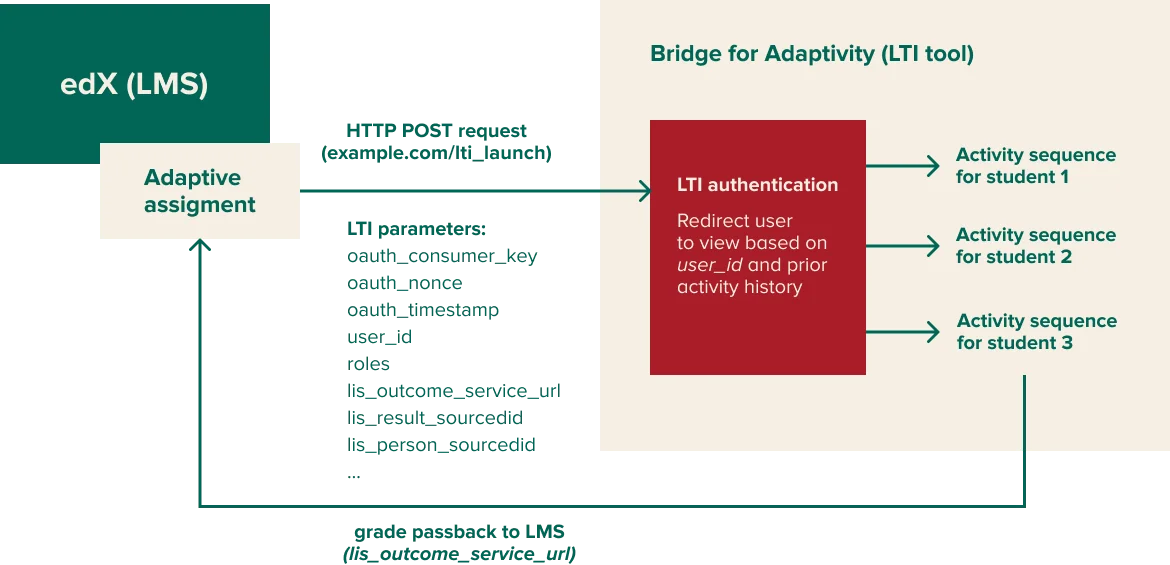HarvardX Adaptivity Bridge:
Elevating LTI Potential
In this case study, we explore unlocking the LTI potential of the HarvardX Adaptive Bridge, with a particular focus on the successful implementation of Adaptive Learning Tools.
Book a call
Introduction
to the HarvardX Adaptivity Project
HarvardX, a University-wide strategic initiative,
is spearheading the development of open online learning experiences and pioneering research in online pedagogies. As part of this groundbreaking endeavor, the Adaptivity Bridge emerges as a vital component within HarvardX's adaptivity effectiveness experiment.
is spearheading the development of open online learning experiences and pioneering research in online pedagogies. As part of this groundbreaking endeavor, the Adaptivity Bridge emerges as a vital component within HarvardX's adaptivity effectiveness experiment.
Challenges
The HarvardX Adaptivity Bridge project tackles several challenges prevalent in the realm of online learning.


Personalized Learning Paths
-
ChallengeProviding personalized learning paths for students with varying needs, preferences, and prior knowledge.
-
SolutionBy implementing adaptivity, the project ensures tailored content and experiences that align with individual requirements.
-
ImpactLearners receive personalized learning journeys, fostering engagement and effectiveness.
Scalability and Efficiency
-
ChallengeScaling online learning platforms and delivering content efficiently to a large number of learners.
-
SolutionThe project optimizes the delivery process, enabling seamless scalability and efficient dissemination of adaptive learning materials.
-
ImpactEnhanced scalability and efficient content delivery for improved learning experiences.
Technical Integration
-
ChallengeComplex and time-consuming integration of adaptive engines, content sources, and learning management systems.
-
SolutionThe project streamlines integration, ensuring seamless communication and synchronization between these components.
-
ImpactReduced technical complexities, facilitating smooth integration and system interoperability.
Limitations
and Complexities
in Adaptivity
Implementation
The path to learning adaptivity and effective analysis is demanding in terms of time and effort. A key challenge is implementing content delivery adaptivity, requiring significant investments.
-
Allocating instructional designer(s)' time to curate materials for diverse learning paths and cater to varying content preferences.
-
Securing funds to address technical complexities, including the selection and integration of adaptive engines, synchronizing them with content and problem sources, learning management systems, as well as internal HR and student register systems.

The Solution:
Simplifying
Adaptivity
Implementation
The HarvardX Adaptivity Project introduces a comprehensive solution to simplify the implementation of adaptivity. One notable advancement within the HarvardX Adaptivity project is the integration of Assessment Tools, which grant educators the ability to customize a diverse range of assessment criteria.

-
Unified Adaptive EngineThe project incorporates a unified adaptive engine that serves as a central hub for managing and delivering adaptive learning experiences.
-
Standardized Integration ProtocolsTo facilitate seamless integration with existing learning management systems (LMS) and content repositories, the project employs standardized integration protocols.
-
User-Friendly Authoring ToolsThe HarvardX Adaptivity project offers user-friendly authoring tools that empower instructional designers and subject matter experts to create adaptive learning experiences with ease.
-
Continuous Improvement FrameworkThe HarvardX Adaptivity project emphasizes a continuous improvement framework, promoting iterative enhancements and refinements to the adaptive learning experience.
Learning Tools Interoperability (LTI):
A Brief Overview
Imagine a classroom where educators effortlessly integrate various learning tools and applications within their existing Learning Management System (LMS). This vision becomes a reality through Learning Tools Interoperability (LTI), a game-changing standard in educational technology.
LTI serves as a bridge, connecting different tools and platforms with the LMS, creating a unified learning experience. With LTI, educators can incorporate external resources like interactive quizzes, multimedia content, collaborative platforms, and assessment systems into their teaching environment.
- Interactive quizzes
- Multimedia content
- Collaborative platforms
- Assessment systems
LTI Bridge
Teaching
Environment
Environment
Understanding LTI
Learning Tools Interoperability (LTI) expands on the brief overview of what LTI is, delving into more detail about its functionality and significance. LTI allows educators to integrate various learning tools and applications within their LMS, enhancing the teaching and learning experience. It facilitates seamless data exchange and automatic sharing of user information between the LMS and integrated tools, eliminating the need for separate logins and manual data entry.
Benefits of Using LTI
in
Education
Using Learning Tools Interoperability (LTI) in education brings numerous benefits to the teaching and learning process.
-
1LTI integration allows educators to incorporate various learning tools, creating a dynamic and interactive learning experience for students.
-
2Students benefit from a wide range of resources, enhancing their understanding and active participation in the learning process.
-
3LTI promotes standardization and ensures seamless compatibility between different tools and platforms, maintaining consistency in the learning ecosystem.
-
4LTI facilitates efficient data flow between integrated tools and the learning management system, streamlining administrative tasks and enhancing overall efficiency.
-
5Educators can manage multiple tools and resources from a single interface, saving time and effort in administrative tasks.

LTI Core
and Optional
Features
Learning Tools Interoperability (LTI) offers both core and optional features that enhance its functionality.
-
Core Features of LTI:
- Seamless integration of external tools and resources within the LMS.
- Automatic sharing of user information for streamlined data exchange.
-
Optional Features of LTI:
- Advanced analytics for personalized learning.
- Content alignment to enhance curriculum coherence.
- Support for additional educational standards.
-
Enhanced Learning Environment:
- LTI's core and optional features empower educators to create a cohesive and engaging learning environment.
- Students benefit from a rich, interactive, and personalized learning experience.
Adaptivity Bridge —
The New Way to Implement Adaptivity
The New Way to Implement Adaptivity
Creating the Content
Source for Adaptivity
To enable adaptability within the learning experience, the process of creating
a content source is designed to be seamless and efficient. Here's a step-by-step overview of how it works:

-
1Identify Relevant Problems: Begin by identifying and gathering problems from courses that are LTI-compatible. These problems serve as the building blocks for the adaptive learning experience.
-
2Preview and Evaluate Problems: Take advantage of the intuitive interface to preview each problem. This allows content creators to assess the suitability and relevance of the problem for the desired learning objectives.
-
3Easy Content Integration: With just one click, add the selected problem (or any other type of content) to the collection. This streamlined process ensures that content sources are quickly assembled and organized for further adaptation.
-
4Fine-tune Difficulty Levels: Tailoring the learning experience is key to effective adaptability. Set the difficulty level for each problem, empowering the adaptivity engine to personalize the learning journey for individual learners.
-
5Fast Collection Gathering: Assembling collections is made easy and efficient. Content creators can swiftly gather related problems, ensuring a comprehensive and cohesive learning experience.

- Problems are gathered in Collections.
- Problems are gathered from courses (courses need to be LTI-compatible).
- One can preview the problem.
- 1 click to add a problem to the collection (or any other type of content).
- One can set the difficulty for the problem for further usage by the adaptivity engine.
- Gathering collections is easy and fast.
Connecting
the Adaptivity
Content
to the LTI Engine

- Collections are gathered in groups for further connection with an adaptivity engine.
- One can choose any adaptivity engine that is LTI-compatible and connect it in the admin settings.
- The adaptivity engine can grade problems.
The integration of adaptive content with the LTI engine is designed to be seamless and efficient, ensuring a smooth and cohesive learning experience. Here's
a description of how the adaptive content is associated with the LTI engine:
-
1Choosing an Adaptivity Engine: Begin by selecting an adaptivity engine that aligns with your specific requirements. The LTI compatibility of the engine allows for easy integration with your learning ecosystem.
-
2Integration in Admin Settings: Once you have chosen the adaptivity engine, the integration process takes place in the admin settings of your platform. Through intuitive configurations, establish a connection between the LTI engine and your content repository.
-
3Adaptive Grading: The adaptivity engine plays a crucial role in grading problems. It utilizes sophisticated algorithms and assessment methodologies to evaluate learners' responses and provide personalized feedback. This adaptive grading system ensures that learners receive tailored assessments based on their individual progress and learning needs.
Elevate Your E-Learning with Raccoon Gang
Schedule a call today to explore the power of adaptive learning, LTI integration, and optimized educational experiences. Take the first step towards transforming your online learning environment with Raccoon Gang as your trusted partner.
Book a call
